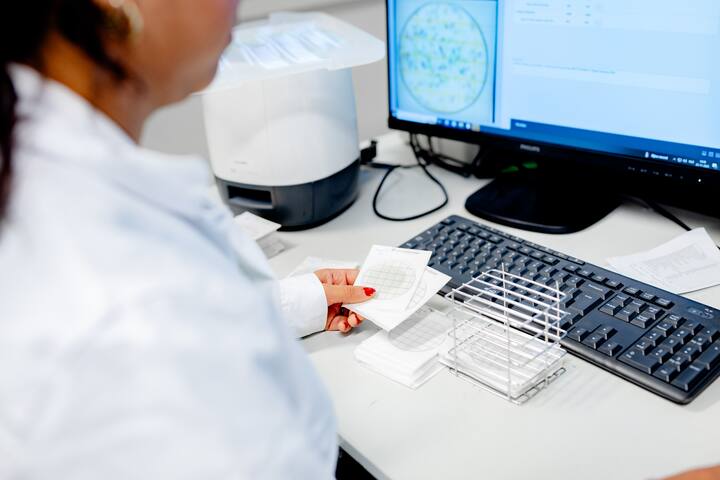
24 June 2025
Challenge testing in the food industry: more than just Listeria
Challenge testing in the food industry: more than just Listeria
Challenge testing involves laboratory tests in which a known number of microorganisms (such as Listeria monocytogenes, Salmonella, Bacillus cereus, yeasts or moulds) are deliberately added to a food product.
The product is then stored under realistic storage conditions (such as temperature, packaging and time) to observe whether and how quickly the microorganism grows, survives or dies. Their purpose is to assess the microbiological safety or shelf life of a specific product in its real matrix and packaging. Challenge tests are best known in the context of Listeria control, but they have many other applications and advantages.
Want to know more about Listeria? Join the course with Wageningen Academy
Challenge testing: a critical part of your food safety management system
Challenge testing is not a ‘nice-to-have’ but a critical part of food safety management. It provides concrete data on the behaviour of microorganisms in your specific products, enabling you to make informed choices about safety, shelf life and quality.

Insight into behaviour
Challenge testing provides insight into the behaviour of microorganisms in a specific product. Every food product has a unique composition (pH, water activity, preservatives, etc.). Challenge testing shows how a pathogen or spoilage organism actually behaves in that product under specific conditions (e.g. during shelf life, refrigerated transport).
Shelf life and safety
Challenge testing ensures validation of shelf life and safety. Testing helps to validate the use-by date, especially for chilled, ready-to-eat products. It can confirm that a product remains safe throughout its shelf life, even if contamination occurs.
A classic shelf life test only tests the status of microorganisms in a specific product at a specific time. The latter is therefore a random sample, while a challenge test provides information about the shelf life of all products within a specific product range.
They also assess the effectiveness of barriers and preservation strategies. How effective are salt, acid, MAP packaging or heat treatment? A challenge test specifically demonstrates the effects of these techniques in your products. They can also demonstrate that a combination of mild preservation techniques (hurdle technology) can be effective against microorganisms such as Salmonella spp., E. coli, B. cereus, yeasts and moulds. Hurdle technology is a food safety strategy that involves applying multiple barriers (hurdles) simultaneously to inhibit or prevent the growth of microorganisms. Instead of one heavy-duty process (such as sterilisation), you combine mild techniques so that they work together effectively without significantly affecting the taste, texture or nutritional value of the product. These techniques are often insufficient on their own to guarantee food safety. As a result, there are no theoretical models to substantiate their safety. A challenge test can therefore provide sufficient substantiation. This allows you to maintain a balance between safety, shelf life and quality.
Legal basis
Challenge testing provides legal substantiation within the framework of the standards for Listeria monocytogenes in Regulation (EU) 2073/2005 in ready-to-eat meals. Please note: the tests are the final piece of the puzzle in a fully substantiated Listeria study. You can read more about this in our white paper on Listeria.
Validation of management systems
The tests also ensure validation of the management systems within the HACCP (GIRA) plans. The results can help substantiate decisions such as temperature control or product reformulation.
By carefully selecting product groups for a challenge test, the results can be used for multiple products. This allows you to immediately determine the shelf life of new products and bring products to market faster, without having to wait for end-of-shelf-life analyses. This is certainly also useful for products with a long shelf life.
Preventing spoilage
Challenge testing provides information about quality retention and spoilage prevention. Challenge testing can also be carried out with spoilage organisms such as yeasts, moulds and lactic acid bacteria. This allows you to test the organoleptic shelf life (taste, smell, appearance) and microbiological stability.
Preventing recalls
Finally, challenge testing can help prevent recalls and damage to your brand. By identifying risks in advance, your company can prevent recalls and food incidents. This saves costs, protects consumers and safeguards your brand image.
Challenge testing: more than just controlling Listeria
Challenge testing can also be very useful for validating the behaviour of microorganisms other than Listeria monocytogenes.
B. cereus
B. cereus forms spores that can survive heat and can produce toxins both before and after consumption. This is particularly a risk in starchy products, such as cooked rice or pasta. These are often stored warm or cooled slowly, which can lead to growth and toxin formation. Dairy products such as desserts and puddings can become contaminated after heating. Cold storage is crucial here. A challenge test will tell you whether and how quickly the bacteria can grow and when toxin production will occur at your storage temperature and duration.
Salmonella
Salmonella spp. is found in raw animal ingredients (meat, eggs, milk) and can multiply at certain temperatures. In chocolate or dry products such as spices, low water activity protects against growth. However, Salmonella can survive for very long periods. The combination of low acidity and moisture poses a risk of growth in chilled, ready-to-eat meals containing raw vegetable components. A challenge test helps to assess the risks and validate the shelf life.
Clostridium
Clostridium botulinum produces life-threatening neurotoxins in anaerobic environments (vacuum, MAP packaging), especially when preservation is inadequate. Under mild storage conditions and preservation, it can therefore pose a risk in MAP-packaged fish and meat products. Growth is also possible in chilled, ready-to-eat meals with low acidity and few preservatives. A challenge test can then demonstrate whether a combination of pH, aw, packaging and temperature is sufficient to prevent growth and toxin formation.
E. coli (STEC)
Escherichia coli (Shigatoxin-producing, STEC) has a very low infectious dose. This makes it dangerous when consumed in raw or only lightly processed products. Raw milk cheeses and cold-smoked meats are examples of this. Vegetable juices and smoothies also carry a risk of growth due to their relatively neutral pH. Validation of the storage conditions in relation to the specific matrix of the products is therefore essential to guarantee the safety of these products.
Yeasts and moulds
These are not always pathogenic but cause spoilage and loss of sensory quality. Juices and sauces containing natural sugars are particularly susceptible to fermentation and gas formation.
Mould can also form on bread and pastries, especially if they have a longer shelf life without preservatives. A challenge test can then show which spoilage organisms dominate, how quickly they grow and whether your preservation is adequate.
Challenge testing versus predictive models
Although predictive microbiological models (such as ComBase or FSSP) provide useful insights, they are no substitute for challenge testing in practice. A challenge test measures what actually happens to microorganisms in your specific product. A model, on the other hand, is based on standard matrices (lab media or generic foods), which can differ significantly from your recipe. A challenge test therefore provides realistic results that reflect the actual risks. Ingredient interactions, fat content, storage technique, packaging (MAP, vacuum), etc. all influence growth. Models often only take pH, aw and temperature into account. A challenge test takes all product and process factors into account simultaneously. During a challenge test, the packaging and environmental conditions are also tested, such as oxygen consumption in MAP-packaged products or temperature fluctuations during distribution. These conditions can be simulated exactly during a challenge test.
Challenge testing provides empirical evidence that your preservation measures (e.g. low pH, salt, pasteurisation) are effective. Models can only estimate.You obtain specific data about your unique product, not an estimate based on assumptions. This is particularly important for borderline cases or innovative products that do not fall within the standard matrices covered by models. Examples include plant-based products and fermentation-based products. A challenge test also reveals the effects of microbial interactions, such as the presence of competitive flora that suppresses pathogens or stimulates their growth. Models rarely take natural contaminants or flora into account. Challenge testing also helps you substantiate decisions, for example when a shelf life extension for products is required. Having a challenge test allows you to make quick and safe decisions in such circumstances, preventing food waste and loss of income.
Hybrid approach: cleverly combining predictive models and challenge testing
Does this mean you cannot use models at all? Not necessarily. Often, a hybrid approach that uses both predictive models and challenge testing is the most efficient and well-founded way to validate food safety and shelf life. Both methods have their strengths, and together they form a powerful tool for risk assessment, product development and validation.

Step 1: Models as initial screening
Predictive models are used as a quick and accessible initial assessment. They help determine whether and when microorganisms can grow in a particular product formulation — for example, will Listeria monocytogenes grow at pH 5.2 and 9°C?
Models are also ideal for comparing different recipes or process settings before you start working in the lab. This allows you to quickly assess whether your product is safe on paper during product development or when changes are made. Is the answer “yes”? Then you can continue. Is the answer “no”? Then you know that adjustments or further investigation are needed.
Step 2: Challenge testing for validation
Once a model indicates that the risk appears to be manageable, challenge testing comes into play. This serves to verify whether the predicted behaviour actually occurs in your specific product matrix.
During a challenge test, you observe under realistic conditions how quickly a microorganism grows, whether toxins develop and whether your product conditions (such as pH, aw, packaging and storage temperature) are really sufficient to inhibit growth. This also ensures that you comply with the requirements of legislation or audits, such as those of the NVWA/FAVV or BRCGS/IFS/FSSC22000.
Step 3: Using models after the test
Predictive models can remain useful even after a challenge test. If the test shows that the behaviour of the bacteria is predictable, you can use models to calculate scenarios, such as the effect of a temporary increase in temperature during transport.
Using dynamic models (such as ComBase or PMP), you can then simulate what happens in the event of temperature fluctuations or minor formulation changes without having to retest each time.
Step 4: Efficient use of resources
A hybrid approach allows you to use resources wisely. By using models as a pre-selection tool, you avoid unnecessary challenge testing in low-risk products. At the same time, you know exactly where to invest in extensive testing, for example when a model does not provide sufficient certainty or when legislation requires it.
This allows you to make the right choices in an efficient and well-founded manner: models for quick go/no-go decisions and challenge testing where it really matters.